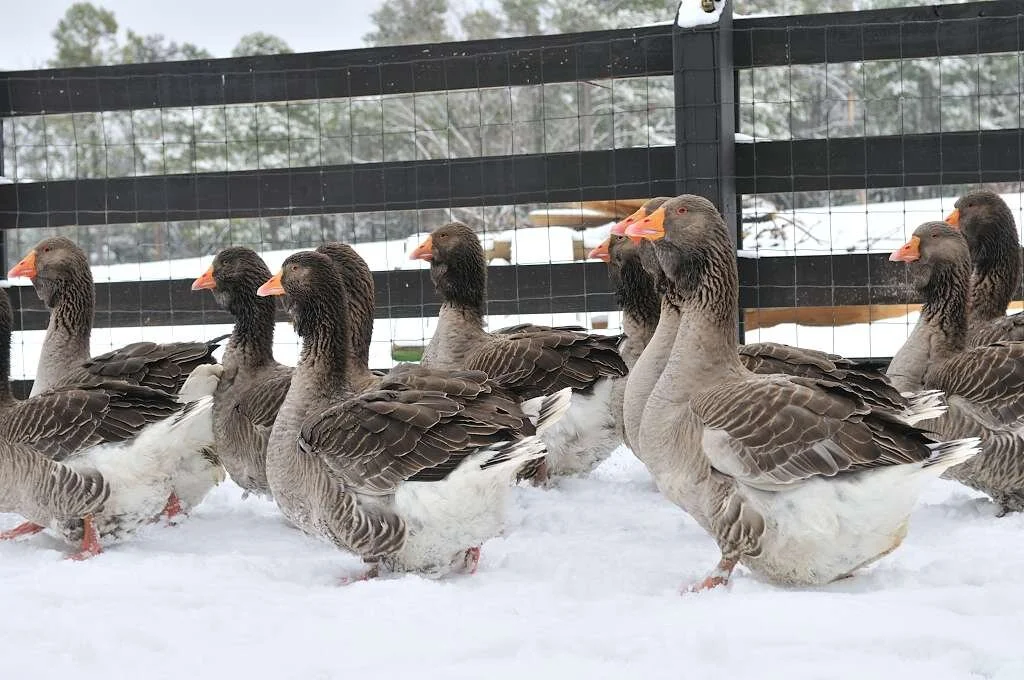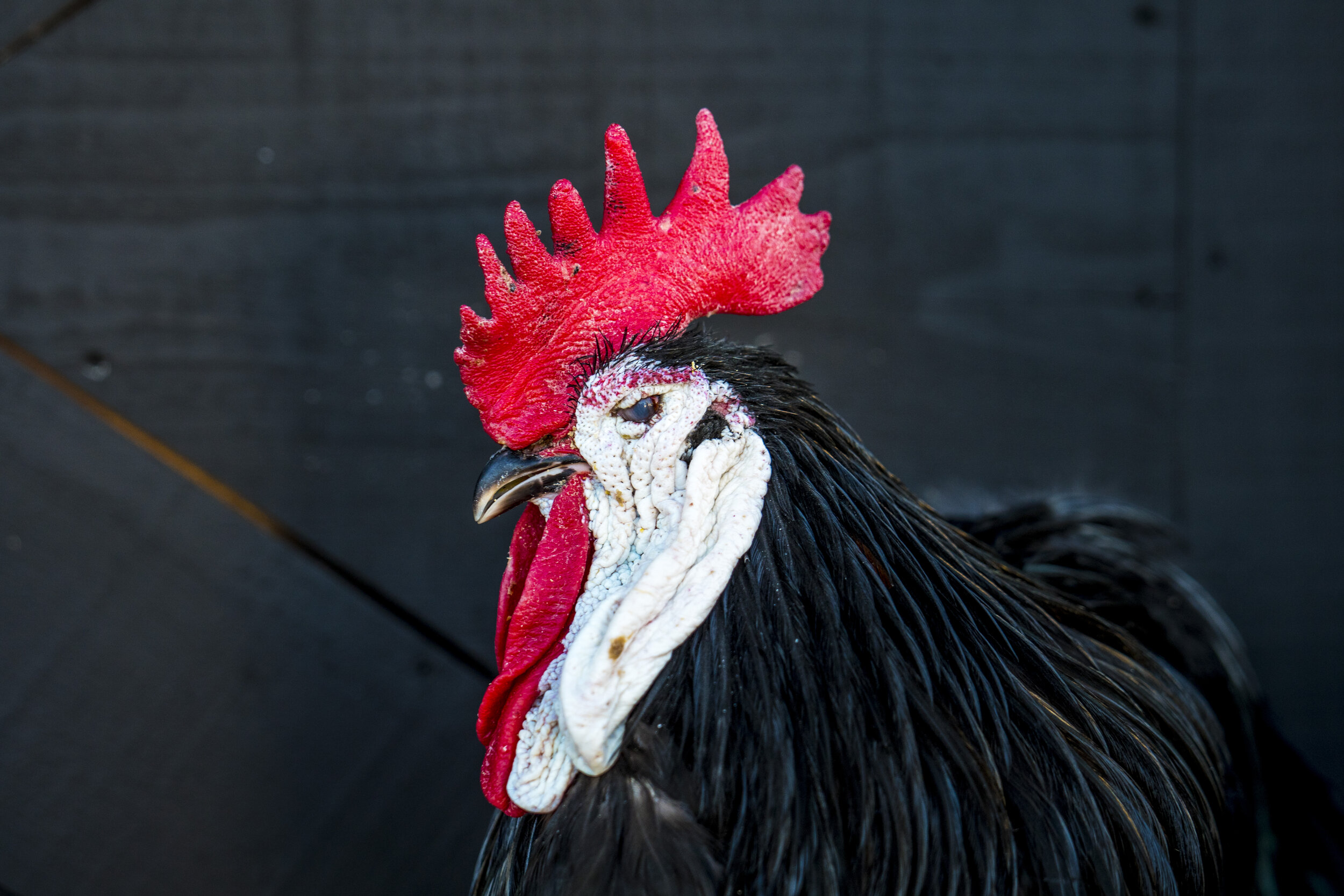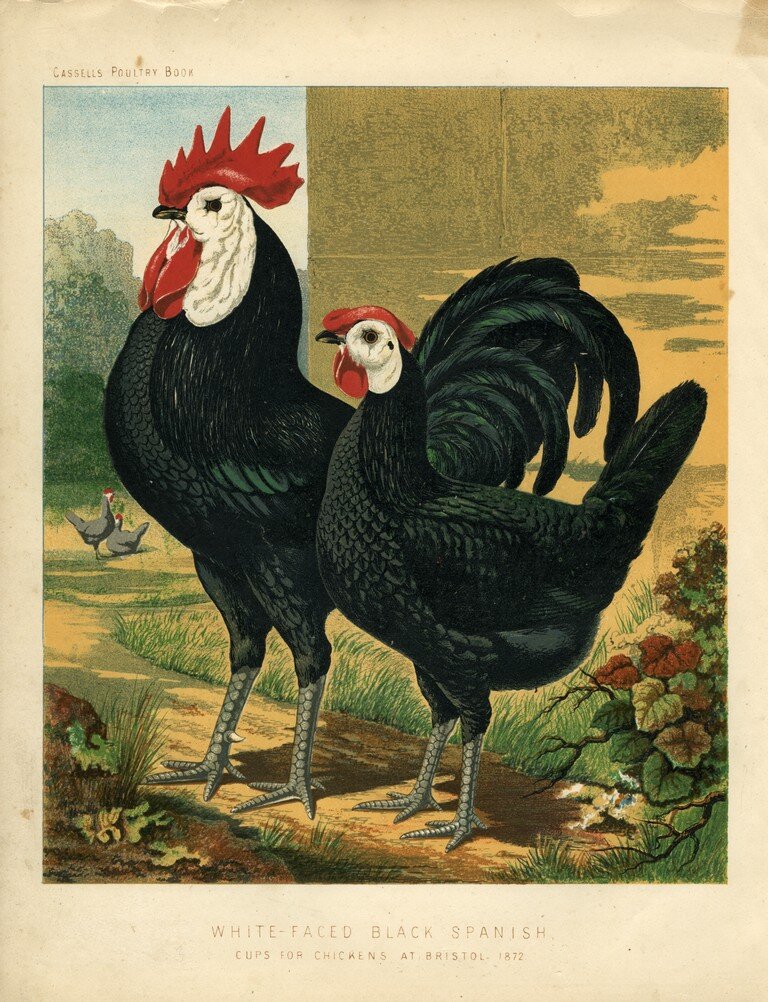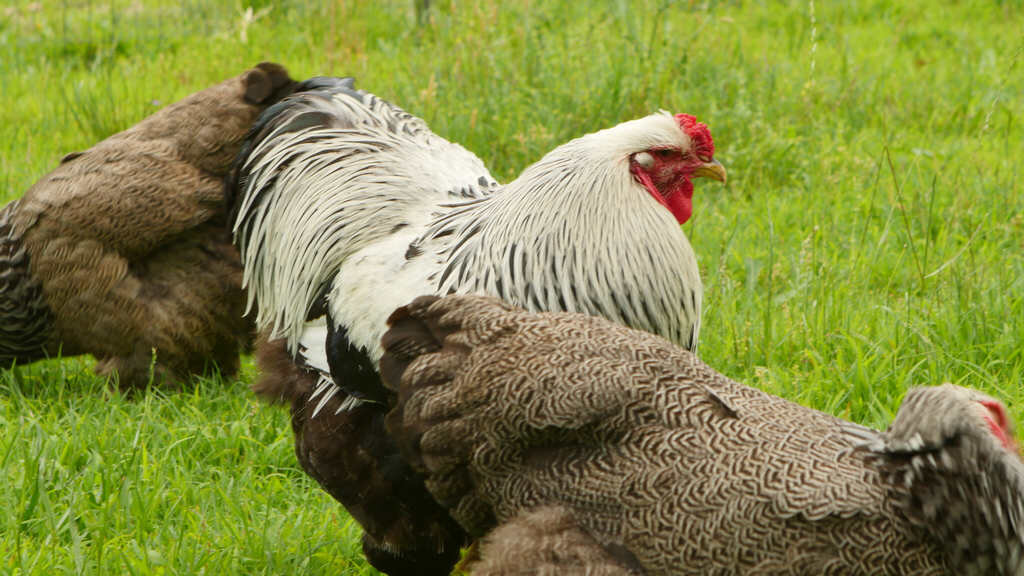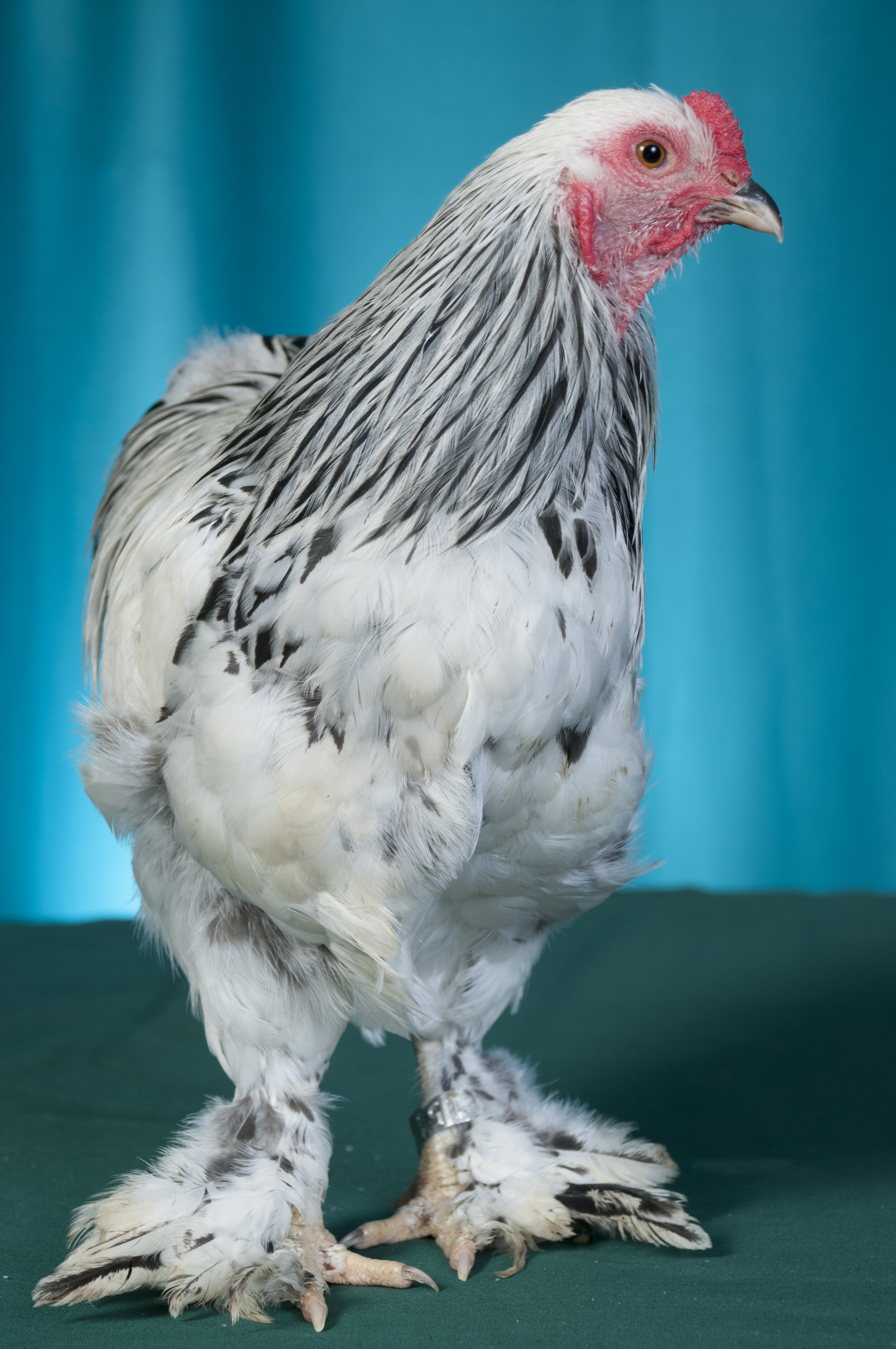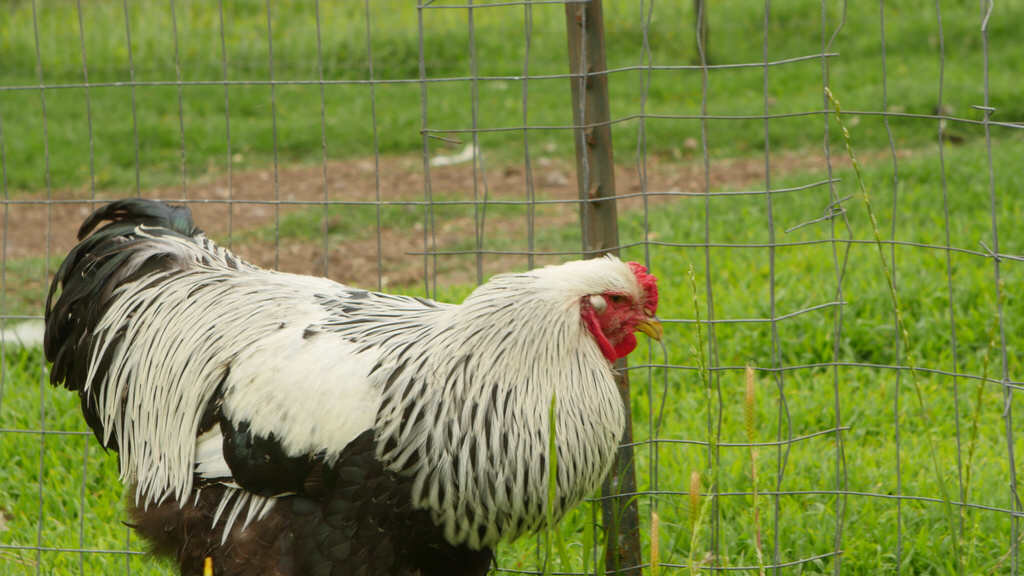The Redcap is a medium-sized bird that was traditionally valued as an egg producer. The skin is white and the eggshells are also white. They are only recognized in one color pattern, that is unique to the breed, and they were admitted to the American Poultry Association’s (APA) Standard of Perfection in 1888.
Standard Weights
Cock: 7.5 lbs.
Hen: 6 lbs.
Cockerel: 6 lbs.
Pullet: 5 lbs.
In Shape the Redcap resembles a heavy egg-type breed, with the body being long, fairly broad and moderately deep. The back is long, broad, and slopes somewhat to the tail, with the tail itself being well-spread and carried at an angle of 45-50°. The breast is broad, prominent and carried up, with the legs being somewhat long and set well apart. The rose comb, which is probably this breed’s most striking feature, is large, wide, and covered with long rounded protuberances and it terminates in a long well-developed spike.
The color pattern of this breed is not found on any other standard breed. In the male, the hackle is black with each feather being edged with red, with the entire feather shading to black at the base. The back is red with the saddles being red striped with black. The wing bows are solid red while the covert feathers are red tipped with a black half-moon spangle. The breast, tail, and body are all black. In the female the hackle feathers are black laced with golden bay. The back, wing fronts, wing bows, breast, tail coverts and body are all rich brown with each feather ending in a black half-moon spangle, while the tail is black. The shanks, feet, and toes, in both the male and female are dark blue while the beak is horn colored. The comb, wattles, face, and earlobes are all supposed to be red. This makes the Redcap one of the few breeds that has red earlobes but lays a white egg.
The Redcap was known by several names over the course of its history including Derbyshire Redcap, Moss Pheasant, and Manchester, with the Redcap part of the name coming from its very large rose comb. It was described by English writers of nearly 100 years ago as comparable to the Golden Spangled Hamburg, and in fact may be closely related to it. Though no positive connection can be made, some Redcap breeders of the late 1800’s believed the Redcap was a result of a cross between Old English Games and Golden Spangled Hamburgs. On the contrary some believed that the Redcap is an older breed than the Golden Spangled Hamburg. Which suggests that the breed is hundreds of years old. Still another theory would suggest that the Golden Spangled Hamburg and the Redcap were developed at the same time and the two types were just selected in two different directions, leading to two very different breeds.
Though no one is 100% sure of the origin of the Redcap, it was at one time very popular in Yorkshire County, particularly around Derbyshire. In fact, Mr. W.H. Baker, a prominent Redcap breeder in the 1920’s and 30’s said that half of the Redcap breeders in the world lived within 10 miles of Derbyshire. Moreover, in Derbyshire they were for a long time considered an excellent and profitable utility breed, and were it not for the breeders in this area, the breed would have become extinct in the early 1900’s. Part of the reason for the breeds decline was the emphasis that breeders put on large combs. Many exhibitors developed the breed’s comb to be exceptionally large and grotesque in appearance, while neglecting the breed’s utility qualities. However, a breed club was eventually organized to revive the Redcap. However, today, the Redcap remains somewhat rare in its home country.
It is not known when the Redcap was first brought to the United States. What we do know is that the breed appears to have been widely distributed in the U.S. before 1870. Additionally, some sources have said that it is possible that the “Red Dorkings” entered in the earliest poultry shows were actually Redcaps. If this is so then that would place the Redcap as being in the U.S. since well before 1870. Whatever the case may be, it is known that until the 1890’s many large flocks of Redcaps were kept for layers by farmers and poultry specialists alike. However, in a few years the breed almost completely disappeared, and to this day is still very rare. Redcaps are rarely seen even at our largest shows, this is one breed that is in very desperate need of more supporters.
As a bird for the home flock the Redcap would make a good choice, where a somewhat heavier egg breed is desired. The females are good layers and historically were said to lay up to 200+ large eggs a year. The hens rarely go broody and they are athletic and active foragers. However, due to to this active nature they may require a higher fence or one with a cover in order to contain them to certain areas. Furthermore, thanks to their larger size the extra cockerels could make good table-birds.
Bantam Redcaps
(Rose Comb Clean Legged class)
Both the APA and American Bantam Association (ABA) recognize the bantam Redcap. The ABA however lists the breed on its “inactive” list. This is simply a list of breeds the organization still recognizes but due to a lack of interest in the breed they do not publish a full description in their Bantam Standard. Shape and color requirements are the same as for large fowl and also like the large fowl the bantam Redcap is very rare, if it even still exists.
Standard Weights
Cock: 30 oz.
Hen: 26 oz.
Cockerel: 26 oz.
Pullet: 24 oz.
Prepared by Michael Schlumbohm
References
Robinson, John H. Popular Breeds of Domestic Poultry. Dayton: Reliable Poultry Journal, 1924.
Brown, Edward. Races of Domestic Poultry. Liss: Nimrod Book Services, 1985.
Scrivener, David. Poultry Breeds and Management an Introductory Guide. Norfolk: The Crowood Press, 2008.
Dohner, Janet V. The Encyclopedia of Historic and Endangered Livestock and Poultry Breeds. New Haven: Yale University, 2001.
The American Standard of Perfection Illustrated: A Complete Description of All Recognized Breeds and Varieties of Domestic Poultry. Burgettstown, PA: American Poultry Association, 2010.
Bantam Standard for the Breeder, Exhibitor, and Judge. 2011 ed. Kansas City: Covington Group, 2011.


